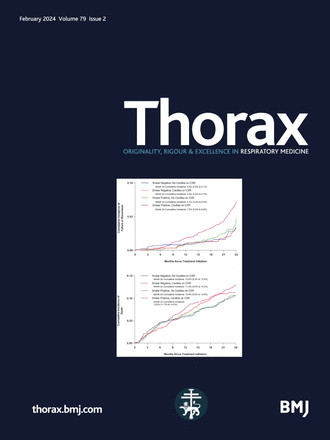鼻孔闭塞和口腔密封对测量嗅鼻吸气压力的影响
IF 9
1区 医学
Q1 RESPIRATORY SYSTEM
引用次数: 0
摘要
嗅鼻吸气压力(SNIP)用于评估肌萎缩性脊髓侧索硬化症(ALS)等神经肌肉疾病的呼吸肌强度。目前还不清楚对侧鼻孔闭塞和口腔密封对 SNIP 测量的影响。该研究共纳入了 81 名参与者(16 名健康人、39 名肢端型 ALS 患者和 26 名球部型 ALS 患者)。SNIP测量采用张口/封口和对侧鼻孔张开/闭合的组合方式。闭合对侧鼻孔(嘴闭合)可使健康参与者的SNIP增加12 cmH2O(95% CI 4, 20; p=0.003),使肢体发病组群的SNIP增加9 cmH2O(95% CI 5, 12; p<0.001),使躯干发病组群的SNIP增加10 cmH2O(95% CI 5, 14; p<0.001)。健康参与者张开嘴后,SNIP 下降了 19 cmH2O (95% CI 5, 34; p<0.009),肢端发病者下降了 8 cmH2O (95% CI 4, 13; p<0.001),球部发病者下降了 13 cmH2O (95% CI 7, 19; p<0.001)。如果对侧鼻孔闭塞,符合无创通气条件的患者将减少 11%。总之,与标准技术相比,对侧鼻孔闭塞会增加 SNIP,这可能反映了真正的强度。张开嘴巴会降低 SNIP,这强调了良好的口腔密封的必要性。记录 SNIP 技术对于纵向评估和临床决策非常重要。本文章由计算机程序翻译,如有差异,请以英文原文为准。
Effect of nostril occlusion and mouth sealing in the measurement of sniff nasal inspiratory pressure
Sniff nasal inspiratory pressure (SNIP) is used to assess respiratory muscle strength in neuromuscular diseases like amyotrophic lateral sclerosis (ALS). The effect of contralateral nostril occlusion and mouth sealing on SNIP measurement are unclear. 81 participants were included (16 healthy, 39 patients with limb-onset ALS and 26 patients with bulbar-onset ALS). SNIP was obtained with combinations of mouth open/sealed and contralateral nostril open/occluded. Occluding the contralateral nostril (with mouth closed) increased SNIP by 12 cmH2O (95% CI 4, 20; p=0.003) in the healthy participants, by 9 cmH2O (95% CI 5, 12; p<0.001) in the limb-onset cohort and by 10 cmH2O (95% CI 5, 14; p<0.001) in the bulbar-onset cohort. Opening the mouth decreased SNIP by 19 cmH2O (95% CI 5, 34; p<0.009) in healthy participants, by 8 cmH2O (95% CI 4, 13; p<0.001) in the limb-onset cohort and by 13 cmH2O (95% CI 7, 19; p<0.001) in the bulbar-onset cohort. With contralateral nostril occlusion, 11% fewer individuals would have qualified for non-invasive ventilation. In conclusion, contralateral nostril occlusion increased SNIP compared with standard technique, likely reflecting true strength. Opening the mouth reduced SNIP, emphasising the need for good mouth sealing. Documenting SNIP technique is important for longitudinal assessments and clinical decision-making.
求助全文
通过发布文献求助,成功后即可免费获取论文全文。
去求助
来源期刊

Thorax
医学-呼吸系统
CiteScore
16.10
自引率
2.00%
发文量
197
审稿时长
1 months
期刊介绍:
Thorax stands as one of the premier respiratory medicine journals globally, featuring clinical and experimental research articles spanning respiratory medicine, pediatrics, immunology, pharmacology, pathology, and surgery. The journal's mission is to publish noteworthy advancements in scientific understanding that are poised to influence clinical practice significantly. This encompasses articles delving into basic and translational mechanisms applicable to clinical material, covering areas such as cell and molecular biology, genetics, epidemiology, and immunology.
 求助内容:
求助内容: 应助结果提醒方式:
应助结果提醒方式:


